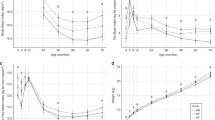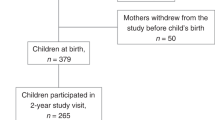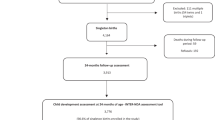Abstract
Objective:
To investigate whether the duration of exclusive breastfeeding and maternal body mass index (BMI) are associated with children's developmental status at the time of beginning elementary school.
Design and subjects:
The subjects in the sample came from a longitudinal study on infant nutrition in Iceland. Food records were made once a month from birth to the age of 12 months, from which duration of exclusive breastfeeding could be determined. Mothers filled in The Icelandic developmental inventory for evaluation of motor and verbal development close to their children's sixth birthday (n=85). Maternal self-reported weight and height was recorded. Information on socioeconomic factors was gathered by a questionnaire.
Results:
Duration of exclusive breastfeeding, in months, was positively related to children's motor component (B=0.5±0.5, P=0.054) and to the total developmental index (B=1.0±0.5, P=0.044) at 6 y, adjusting for gender and socioeconomic factors (maternal and paternal education, and family income). Children's learning score was negatively related to maternal BMI (B=−0.5±0.2, P=0.047). An inverse association also appeared between maternal BMI and two out of the three developmental composite scores, that is, verbal component and the total developmental index (B=−0.6±0.3, P=0.049) and (B=−0.4±0.2, P=0.057), respectively. In multiple regression the developmental indexes were most strongly independently associated with maternal BMI (negatively) and infants’ birth weight (positively).
Conclusion:
Maternal BMI and duration of breastfeeding were associated with verbal and motor development of 6-y-old children, independent of socioeconomic factors. Birth weight was also an independent determinant for developmental scores.
Sponsorship:
This study was supported by research grants to the first author from The Icelandic Research Council, The Icelandic Student Innovation Fund. Masters and PhD students were supported by The Icelandic Ministry of Agriculture, The Icelandic Dairy Marketing Board and The Icelandic Dairy and Beef Farmers Association.
This is a preview of subscription content, access via your institution
Access options
Subscribe to this journal
Receive 12 print issues and online access
$259.00 per year
only $21.58 per issue
Buy this article
- Purchase on Springer Link
- Instant access to full article PDF
Prices may be subject to local taxes which are calculated during checkout
Similar content being viewed by others
References
Anderson JW, Johnstone BM & Remley DT (1999): Breast-feeding and cognitive development: a meta-analysis. Am. J. Clin. Nutr. 70, 525–535.
Angelsen NK, Vik T, Jacobsen G & Bakketeig LS (2001): Breast feeding and cognitive development at age 1 and 5 years. Arch. Dis. Child. 85, 183–188.
Atladottir H & Thorsdottir I (2000): Energy intake and growth of infants in Iceland—a population with high frequency of breast-feeding and high birthweight. Eur. J. Clin. Nutr. 54, 695–701.
Camp BW, Broman SH, Nichols PL & Leff M (1998): Maternal and neonatal risk factors for mental retardation: defining the ‘at-risk’ child. Early Hum. Dev. 50, 159–173.
Crisp AH & McGuinness B (1976): Jolly fat: relation between obesity and psychoneurosis in general population. BMJ 1, 7–9.
Faith MS, Matz PE & Jorge MA (2002): Obesity–depression associations in the population. J. Psychosom. Res. 53, 935–942.
Feingold C (1994): Correlates of cognitive development in lowbirth-weigth infants from low income families. J. Pediatr. Nurs. 9, 91–99.
Florey CD, Leech AM & Blackhall A (1995): Infant feeding and mental and motor development at 18 months of age in first born singletons. Int. J. Epidemiol. 24 (Suppl 1), S21–S26.
Gudmundsson E & Gretarsson SJ (1993): The reliability and validity of the Icelandic Parent Development Inventory for children from 36 months to 72 months. Educ. Psychol. Meas. 53, 571–584.
Gudmundsson E & Gretarsson SJ (1994): Adult's estimates of pre-school children's verbal and motor abilities compared with those children's scores on an individual developmental test. Early Dev. Parent. 3, 161–170.
Gunnarsdottir I & Thorsdottir I (2003): Relationship between growth and feeding in infancy and body mass index at the age of 6 years. Int. J. Obes. Relat. Metab. Disord. 27, 1523–1527.
Helland IB, Saarem K, Saugstad OD & Drevon CA (1998): Fatty acid composition in maternal milk and plasma during supplementation with cod liver oil. Eur. J. Clin. Nutr. 52, 839–845.
Helland IB, Smith L, Saarem K, Saugstad OD & Drevon CA (2003): Maternal supplementation with very-long-chain n-3 fatty acids during pregnancy and lactation augments children's IQ at 4 years of age. Pediatrics 111, e39–e44.
Istvan J, Zavela K & Weidner G (1992): Body weight and psychological distress in NHANES I. Int. J. Obes. Relat. Metab. Disord. 16, 999–1003.
Karlsson J, Taft C, Sjostrom L, Torgerson JS & Sullivan M (2003): Psychosocial functioning in the obese before and after weight reduction: construct validity and responsiveness of the obesity-related problems scale. Int. J. Obes. Relat. Metab. Disord. 27, 617–630.
Koletzko B & Rodriguez-Palmero M (1999): Ployunsaturated fatty acids in human milk and their role in early infant development. J. Mamm. Gland Bio. Neoplasia 4, 269–284.
Lande B, Andersen LF, Baerug A, Trygg KU, Lund-Larsen K, Veierod MB & Bjorneboe GE (2003): Infant feeding practices and associated factors in the first six months of life: the Norwegian infant nutrition survey. Acta Paediatr. 92, 152–161.
Li R, Ogden C, Ballew C, Gillespie C & Grummer-Strawn L (2002): Prevalence of exclusive breastfeeding among US infants: the Third National Health and Nutrition Examination Survey (Phase II, 1991–1994). Am. J. Public Health 92, 1107–1110.
Lucas A & Morley R (1992): Breast milk and subsequent intelligence quotient in children born preterm. Lancet 339, 261–264.
Lucas A, Morley R & Cole TJ (1998): Randomized trial of early diet in pre-term babies and later intelligence quotient. BMJ 317, 1481–1487.
Neggers YH, Goldenberg RL, Ramey SL & Cliver SP (2003): Maternal prepregnancy body mass index and psychomotor development in children. Acta Obstet. Gynecol. Scand. 82, 235–240.
Peeters A, Barendregt JJ, Willekens F, Mackenbach JP, Mamun AA & Bonneux L (2003): Obesity in adulthood and its consequences for life expectancy: a life-table analysis. Ann. Intern. Med. 138, 24–32.
Ramsay MC & Reynolds CR (2000): Does smoking by pregnant women influence IQ, birth weigth, and developmental disabilities in their infants? A methodological review and multivariate analysis. Neuropsychol. Rev. 10, 1–40.
Richards M, Hardy R, Kuh D & Wadsworth MEJ (2001): Birth weight and cognitive functions in the British 1946 birth cohort: longitudinal population based study. BMJ 322, 199–203.
Rutishauser IH & Carlin JB (1992): Body mass index and duration of breast-feeding: a survival analysis during the first six months of life. J. Epidemiol. Community Health. 46, 559–565.
Sichieri R, Field AE, Rich-Edwards J & Willet WC (2003): Prospective assessment of exclusive breastfeeding in relation to weight change in women. Int. J. Obes. Relat. Metab. Disord. 27, 815–820.
Stewart AL & Brook RH (1983): Effects of being overweight. Am. J. Public Health 73, 171–178.
Sullivan M, Karlsson J, Sjostrom L, Backman L, Bengtsson C, Bouchard C, Dahlgren S, Jonsson E, Larsson B, Lindstedt S, Näslund I, Olbe L & Wedel H (1993): Swedish obese subjects (SOS)—an intervention study of obesity. Baseline evaluation of health and psychosocial functioning in the first 1743 subjects examined. Int. J. Obes. Relat. Metab. Disord. 17, 503–512.
Thorgeirsdottir H, Steingrimsdottir L, Olafsson O & Gudnason V (2001): Trends in overweight and obesity in 45–64 year old men and women in Reykjavik 1975–1994. Icelandic Med. J. 87, 699–704 (in Icelandic).
Thorsdottir I & Birgisdottir BE (1998): Different weight gain in women of normal weight before pregnancy: postpartum weight and birth weight. Obstet. Gynecol. 92, 377–383.
Thorsdottir I, Gunnarsson BS, Atladottir H, Palsson G & Michaelsen KF (2003a): Iron status at 12 months of age—effects of body size, growth and diet in a population with high birth weight. Eur. J. Clin. Nutr. 57, 505–513.
Thorsdottir I, Gunnarsdottir I & Palsson GI (2003b): Association of birth weight and breast-feeding with coronary heart disease risk factors at the age of 6 years. Nutr. Metab. Cardiovasc. Dis. 13, 267–272.
Uauy R & De Andraca I (1995): Human milk and breast feeding for optimal mental development. J. Nutr. 125 (Suppl 8), S2278–S2280.
Vestergaard M, Obel C, Henriksen TB, Sorensen HT, Skajaa E & Ostergaard J (1999): Duration of breastfeeding and developmental milestones during the latter half of infancy. Acta Paediatr. 88, 1327–1332.
Wadden TA, Stunkard AJ & Liebschutz J (1988): Three-year follow-up of the treatment of obesity by very low calorie diet, behavior therapy, and their combination. J. Consult. Clin. Psychol. 56, 925–928.
Wadden TA, Vogt RA, Andersen RE, Bartlett SJ, Foster GD, Kuehnel RH, Wilk J, Weinstock R, Buckenmeyer P, Berkowitz RI & Steen SN (1997): Exercise in the treatment of obesity: effects of four interventions onbody composition, resting energy expenditure, appetite, and mood. J. Consult. Clin. Psychol. 65, 269–277.
World Health Assembly (2001): Infant and Young Child Nutrition Resolution No. WHA 54.2. Geneva: World Health Organization.
World Health Organization (1998): Obesity: Preventing and Managing the Global Epidemic. Report of a WHO consultation, Geneva, 3–5 June 1997. WHO/NUT/98.1. Geneva: WHO.
Author information
Authors and Affiliations
Corresponding author
Additional information
Guarantor: I Thorsdottir.
Contributors: IT, IG and SJG participated in the project planning. IT was the project leader and made the greatest contribution to this paper. MAK and IG worked on the calculation and statistical analysis and wrote the first draft of the manuscript. All investigators contributed to the writing of the final paper.
Rights and permissions
About this article
Cite this article
Thorsdottir, I., Gunnarsdottir, I., Kvaran, M. et al. Maternal body mass index, duration of exclusive breastfeeding and children's developmental status at the age of 6 years. Eur J Clin Nutr 59, 426–431 (2005). https://doi.org/10.1038/sj.ejcn.1602092
Received:
Revised:
Accepted:
Published:
Issue Date:
DOI: https://doi.org/10.1038/sj.ejcn.1602092
Keywords
This article is cited by
-
Competing priorities: a qualitative study of how women make and enact decisions about weight gain in pregnancy
BMC Pregnancy and Childbirth (2020)
-
Maternal Obesity: Risks for Developmental Delays in Early Childhood
Maternal and Child Health Journal (2016)
-
The Effect of Breastfeeding on Neuro-Development in Infancy
Maternal and Child Health Journal (2013)



